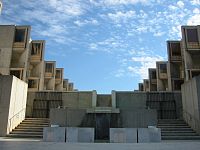| Revision as of 00:02, 10 September 2006 edit88.73.92.70 (talk)No edit summary← Previous edit | Revision as of 18:12, 21 September 2006 edit undoWarriorScribe (talk | contribs)1,372 editsNo edit summaryNext edit → | ||
| Line 1: | Line 1: | ||
| ]]The '''Salk Institute for Biological Studies''' is an independent non-profit educational research |
]]The '''Salk Institute for Biological Studies''' is an independent, non-profit, educational research laboratory located in ]. It was founded in 1960 by ], M.D., the developer of the polio vaccine. Among the founding consultants were ] and ]. | ||
| The institute has 56 labs and focuses its research in three areas: ] and ]; ]s; and ] Biology. Research topics include ], ], birth defects, ], ], ] |
The institute has 56 labs and focuses its research in three areas: ] and ]; ]s; and ] Biology. Research topics include ], ], birth defects, ], ], and ]. | ||
| The ] provided the initial funding and continues to support the institute. The campus was designed by ]. Salk had sought to make a beautiful campus in order to draw the best researchers in the world. The original buildings of the Salk Institute were designated as a historical landmark in 1991. | The ] provided the initial funding and continues to support the institute. The campus was designed by ]. Salk had sought to make a beautiful campus in order to draw the best researchers in the world. The original buildings of the Salk Institute were designated as a historical landmark in 1991. | ||
| Line 8: | Line 8: | ||
| ==History== | ==History== | ||
| Salk and Kahn approached the city of ] in March 1960 about a gift of land on the ] and were granted their request after a ] in June 1960. Construction began in 1962 and a handful of researchers moved into the first laboratory in 1963. | Salk and Kahn approached the city of ] in March 1960 about a gift of land on the ] and were granted their request after a ] in June 1960. Construction began in 1962 and a handful of researchers moved into the first laboratory in 1963. Additional buildings housing more laboratories as well as the organizational administrative offices were constructed in the 1990s, following Kahn's original designs. | ||
| Jonas Salk died in 1995. A memorial lies at the entrance to the Institute: "Hope lies in dreams, in imagination and in the courage of those who dare to make dreams into reality." | Jonas Salk died in 1995. A memorial lies at the entrance to the Institute: "Hope lies in dreams, in imagination and in the courage of those who dare to make dreams into reality." | ||
Revision as of 18:12, 21 September 2006


The Salk Institute for Biological Studies is an independent, non-profit, educational research laboratory located in La Jolla, California. It was founded in 1960 by Jonas Salk, M.D., the developer of the polio vaccine. Among the founding consultants were Jacob Bronowski and Francis Crick.
The institute has 56 labs and focuses its research in three areas: Molecular Biology and Genetics; Neurosciences; and Plant Biology. Research topics include cancer, diabetes, birth defects, Alzheimer's disease, Parkinson's disease, and AIDS.
The March of Dimes provided the initial funding and continues to support the institute. The campus was designed by Louis Kahn. Salk had sought to make a beautiful campus in order to draw the best researchers in the world. The original buildings of the Salk Institute were designated as a historical landmark in 1991.
The institute currently employs more than 1200 researchers and staff.
History
Salk and Kahn approached the city of San Diego in March 1960 about a gift of land on the Torrey Pines Mesa and were granted their request after a referendum in June 1960. Construction began in 1962 and a handful of researchers moved into the first laboratory in 1963. Additional buildings housing more laboratories as well as the organizational administrative offices were constructed in the 1990s, following Kahn's original designs.
Jonas Salk died in 1995. A memorial lies at the entrance to the Institute: "Hope lies in dreams, in imagination and in the courage of those who dare to make dreams into reality."